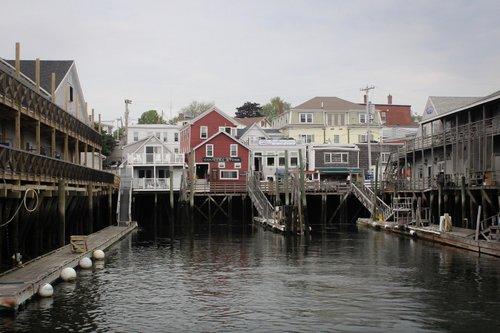Fact or fiction: graduate programs in Europe are worth it
Apr 12, 2023
9 mins


US Editor at Welcome to the Jungle
Going to college is so expensive it can leave students with heavy debt for years to come. That burden is even higher for those who go on to take an advanced degree — even though it may have been done simply to boost their earning power. It can take decades to pay off these loans. That’s why some students are heading to European colleges and universities, which often charge much lower fees. So is it worth building up huge debts just to get a postgraduate qualification from a North American institution? Or are those heading to Europe on to a good thing? We spoke to a recruiter and six students who have studied in Europe to find out.
Hefty college costs greatly influence the lives of American students and graduates. It can take decades to pay back loans taken out to cover undergraduate fees and living costs. Those who go on to take a postgraduate qualification, such as a master’s degree, to improve their job prospects and earning potential end up with even bigger debts. Barack Obama was in his forties by the time he had paid off his student debt in 2005. If he were at Harvard Law school now, he would have to pay at least $111,500 a year for his studies and living expenses, leaving him with at least $223,000 in student debt on finishing.
Over the past 20 years, college tuition fees have shot up, increasing by 132% after adjusting for inflation. The average cost of a master’s degree during the 2019-20 academic year was $21,412. Most graduate degree holders carry cumulative student loan debt of more than $80,000, according to the Education Data Initiative. For graduate school alone, the average debt is more than $60,000.
That has made institutions overseas look attractive to many Americans. During the 2018-19 academic year – which was before the pandemic kept everyone at home – 347,099 US students studied abroad, according to the Institute of International Education (IIE), which conducts an annual census report on US students abroad. More than half of those went to Europe, which has been consistently popular.
Some students choose to stay in Europe to work afterwards too. Work-life balance and culture are the top reasons for pursuing a career in Europe rather than the US. The OECD ranks the US 30th out of the 38 countries in its index, and according to a new International Labour Organization report, US workers typically put in 400 more hours on the job every year than their German counterparts.
Getting the best education
America’s top universities are among the best in the world, but European universities also hold many spots on the world’s top 100 list, according to Times Higher Education. Obama’s Harvard law degree is ranked second in the world, behind Oxford University’s in England. So how do other European universities compare to US schools, and are the qualifications transferable?
Adina Volle, an international recruiter based in Boone, North Carolina, says European colleges are rigorous and some courses are quite intense. “I studied in Europe and here in the US. I can tell you, based on my experience, European colleges are pretty hardcore, but I wouldn’t go as far to say one is better than the other,” she says.
Volle says the qualification is more likely to be transferable for those studying humanities, political science, or business. This is reflected in Americans’ choices abroad, with a majority studying business and management, social sciences, foreign languages and international studies, or physical and life sciences.
Volle warns that some international degrees might be harder to use back in the US. “For example, medical and law degrees are harder to compare and transfer,” she says. As laws differ between countries, most “boards would require you to take some extra training and exams when returning to the US,” Volle adds. If in doubt, the US Department of Education provides a list of technical career governing bodies to help students to determine whether a foreign degree is recognized in the US.
Volle, who works for an international humanitarian aid organization, says there is a slight recruitment bias against European degrees. “Recruiters often base [their opinion of] candidates on their college because they know its reputation. We think of Oxford, Cambridge, etc in Europe, but American recruiters don’t typically inform themselves about other colleges abroad,” she says. This is an issue, according to Volle.
If you are looking at a career with a global focus, Volle says studying abroad will boost your prospects regardless of the industry. “You will be stretched during the experience, and this allows you to have adaptability, openness to others, and resilience,” she says.
How much does it cost to study in Europe?
The surprise is how little it can cost in Europe. Graduate programs range in price from zero – for many postgraduate courses in Germany – to tens of thousands of euros,* but they are lower generally than in North America. How much an international student has to pay depends on such factors as: the country, level of study, course duration, subject area and type of institution. Some fees have increased in recent years too. When the fees are low, tuition is usually in the host country’s language.
So how realistic is the European option, and how does it affect a student’s career prospects back in the US? This is what some students had to say:
Amy Garlesky, communications in France
Amy Garlesky, from Cleveland, Ohio, built up a lot of debt studying for a master’s degree in social policy and philosophy at George Washington University. So she decided to take on a second master’s to boost her employment prospects – but one with low fees this time. Garlesky pays fees of less than $300 a year to study in France. This wasn’t easy as her classes are taught through French. She had to study hard to attain the necessary level but feels it was worth it. “My US master’s came with financial strings. I chose to do a master’s in communications at the Paul Valery Montpellier III [university] in the south of France because it would be good for my career, and my tuition is only €243 ($256) a year,” she says.
During her two-year program, Garlesky has been working for a tech startup in digital marketing and content design as well as attending college. She can do this as she is taking part in Cooperative Education (Co-Op), which operates as a combined work-study scheme. “It’s preparing me for the future because I freelanced [in] tech before, but this is a chance to work [for] two years within an organization that is growing rapidly,” she says. Garlesky also gets paid. “I have two weeks of class and two weeks of full-time work. I get paid the minimum wage monthly salary in France, €1,709.28 ($1,834.63)] and I don’t have to pay taxes,” she adds. She uses this to cover living expenses.
Payments on her previous loans, which are all federal, have been paused with the COVID-19 Emergency Relief and Federal Student Aid. Overall, Garlesky is not stressed about paying back these loans after her degree. She adds, “Considering I didn’t need to take out any loans for my current program, I’m not particularly worried.”
Karl Greenfield, comparative politics in France
Karl Greenfield from New York City also chose France. He studied comparative politics through French at the University of Montpellier and paid the same fees of $256 as Garlesky. Greenfield says, “I think it’s viewed as a very elitist thing by some people. But I think Americans are blind to the possibilities.” Living in France is cheaper than “just existing in the US. You get inexpensive healthcare and housing allowances,” he says, adding that, most importantly, “you’re in a beautiful place many people would dream of going to.”
He has since returned to New York where he is doing a master’s in climate and society at Columbia Climate School at Columbia University. Now in his second semester, he is starting to understand why some choose to study there, despite the exorbitant fees. “I hadn’t realized the bias that exists in higher education, but once I was at Columbia, and I saw what types of doors opened, I realized you’re not paying for the classes; you’re paying for access and the network,” he says.
Greenfield is confident that after he graduates, he will find a higher-paying, more senior role than he could have if he had stayed in Europe. Greenfield says, “I could have led a respectable life working in France after my degree, but I don’t think I could have done anything exceptionally high-powered, which is what I want.”
Anamarie Gundersen, cancer biology in England
You don’t need to know a foreign language to benefit from lower tuition costs. Anamarie Gundersen from North Carolina has just finished her degree in cancer biology at the University of Essex in England. Master’s courses in the UK typically last one year and Gundersen’s decision was based on tuition costs. “I paid around $18,000 for my degree. If I had gone to the US, I would have paid $10,000 to $20,000 a year for three years,” she says. She had a full-ride scholarship for her primary degree, so she was comfortable taking out a loan for this.
Gundersen chose her program for the professional research opportunities it will yield. “A professor at the university was conducting the same research I wanted to pursue. Now, with another lecturer and my supervisor, we are publishing a paper together next month,” she says. She has made invaluable connections during her degree and plans to work for a few years in her field in the UK after her visa comes through before returning to the United States.
Nicolas Klapmeyer, international development in England
Nicolas Klapmeyer chose to do his degree in Europe as he had debts hanging over him from his time as an undergraduate at the American University in Washington DC. After gaining his primary degree, Klapmeyer worked to save up to pay for his master’s degree, though in the end he didn’t go for the cheapest option. “I was initially looking in Germany and Scandinavia as they have, basically, free tuition, but I chose the University of Manchester in England for the program’s reputation. It was around $17,000 for my degree versus around $140,000 in the US,” he says.
Klapmeyer did his master’s in international development, focusing on conflict, poverty, and reconstruction. “My school has one of the best degrees in the world for what I was doing,” he says. After returning to DC, Klapmeyer quickly found a job in his field at International Foundation for Lateral Systems, a democracy-building non-governmental organization. “I only stayed back in DC for about nine months before I wanted to leave again,” he says. Klapmeyer returned to Europe for what he considers “a better work-life balance.”
Allegra Peery, public health in France
Although Allegra Peery chose to go to France, she has been able to study public health through English. She is studying for an English master of public health at Ecole des Hautes études en Santé Publique (EHESP School of Public Health) in Paris. She explains her reasoning. “I was looking at similar programs at [the University of North Carolina] and Duke [university in North Carolina] with tuition ranging from $70,000 to $90,000 for the two years,” she says. “For me, the debt wasn’t worth it for the degree that I was getting. I will never be making millions in my public health career.” Peery pays €5,500 ($5,797) per year for the two-year program, and it offers a payment plan option that allows her to pay out of pocket. Perry says, “I was interested in global health as a whole and now I am learning through direct experience living abroad. I will definitely try to leverage this during my job hunt.”
Peery is not sure she will be able to find work in Europe after finishing her degree. “They have a good, functioning health care system here already, so the need is much lower in comparison to what is needed back in the US,” she says, though the work-life balance is tempting and she is enjoying her time in the French capital.“It’s hard not to like it here. Studying in a place with such a rich history and so many different cultures – I love being in that environment,” she says.
Molly Amon, veterinary medicine in Ireland
Getting on to the right program was a factor for some students, such as Molly Amon, who is in the veterinary graduate program at University College Dublin. Her overall costs in Ireland are higher than if she had stayed in North Carolina and gone in-state, living with family, but her local program was highly competitive. “It’s easier to get in abroad compared to out-of-state programs. They only take like 20 out-of-state students a year. Plus, not everybody wants to go abroad, so fewer people are vying for spots,” she says. With a four-year veterinary medicine degree at UCD costing about €40,000, the American Association for Veterinary Medical Colleges’ comparison tool shows Amon’s tuition as a little under $151,000 compared to out-of-state schools, which range from about $250,000 to $535,000. Amon can keep pursuing her career goals for the same average price as it would have been in the US – while not exceeding her budget.
If she were to stay in Ireland, Amon does not think she could repay her loans. She says, “I have the same amount of debt now as I would if I had gone to an out-of-state school, and [Irish vets] don’t get paid nearly as much as their US counterparts.” Amon believes she will be able to repay her loans comfortably after she returns to the US, where she can earn a higher salary. The American Veterinary Medicine Association approves Amon’s program, so her degree is equivalent to any she would have been awarded in the US or Canada.
- Fees were correct at time of publication
Photo: Welcome to the Jungle
Follow Welcome to the Jungle on Facebook on LinkedIn and on Instagram and subscribe to our newsletter to get our latest articles every day!

More inspiration: Relocate for work

Fancy moving to Dublin, Ireland to work? Here’s what you can expect
Discover what makes Ireland's capital a top destination for professionals worldwide.
Apr 16, 2024

Moving to NYC for work? Here's what you need to consider
What is the reality of living and working in The Big Apple? The truth has to lie somewhere between Sex and the City and Taxi Driver.
Jan 10, 2024

The 2023 guide to living and working in Portland, Maine
As the cost of living in East-Coast naves like Boston and New York keeps rising, Portland is emerging as a top choice for big-city defectors.
Mar 21, 2023

Moving to the country in a post-pandemic world
As remote and flexible work edges toward ubiquity, roughly half of Americans would already prefer a rural area to a city or suburb
Feb 13, 2023

Working in Chicago
Thinking about relocating to the Windy City? Two residents share their experience and insights
Dec 07, 2022
The newsletter that does the job
Want to keep up with the latest articles? Twice a week you can receive stories, jobs, and tips in your inbox.

Looking for your next job?
Over 200,000 people have found a job with Welcome to the Jungle.
Explore jobs